What is Feedback mechanism?
- A feedback mechanism, rooted in the principles of cybernetics, is a fundamental regulatory system prevalent in both biological and non-biological systems. It operates as a loop, responding to perturbations or changes either by amplifying (positive feedback) or counteracting them (negative feedback). This mechanism is quintessential for maintaining a state of equilibrium or homeostasis, especially in biological systems.
- In the realm of biology, a feedback mechanism is not merely a loop but a complex interplay of biological processes, signals, and mechanisms. These processes either initiate and accelerate or inhibit and decelerate a particular response.
- For instance, the secretion of the hormone oxytocin during the onset of childbirth contractions exemplifies a positive feedback loop. The hormone’s release intensifies the contractions, thus perpetuating the cycle. Conversely, the regulation of blood glucose levels showcases a negative feedback loop.
- Elevated blood glucose levels can be detrimental, potentially leading to conditions like diabetes. Hence, the body employs negative feedback mechanisms to regulate and maintain glucose levels within a safe range.
- Feedback mechanisms are not limited to biological systems alone. The term originated in the field of cybernetics, emphasizing a system’s capacity to adjust its output based on received input. In essence, it is a system’s inherent ability to self-regulate and adapt.
- To further elucidate, feedback mechanisms can be categorized into two primary types: positive and negative. In a positive feedback mechanism, the activation of one component stimulates the activation of another, reinforcing the initial stimulus. This often leads to an amplification of the response.
- On the other hand, a negative feedback mechanism operates in a counteractive manner. Here, the activation of one component results in the suppression or inactivation of another, ensuring that the system returns to its baseline or equilibrium state.
- In summary, feedback mechanisms, whether positive or negative, play a pivotal role in maintaining the stability and functionality of various systems, from biological entities to intricate cybernetic systems. Their precise and dynamic nature underscores their significance in ensuring the harmonious operation of complex systems.
Definition of Feedback mechanism
A feedback mechanism is a regulatory system within a process or organism that responds to changes by either amplifying (positive feedback) or counteracting (negative feedback) them to maintain equilibrium or homeostasis.
Open and Closed-Loop Feedback Mechanisms
Feedback loops are integral components in the maintenance of homeostasis within biological systems. These loops are meticulously designed systems comprising three primary components: the receptor (sensor), the control center (integrator or comparator), and the effector. The receptor identifies and relays physiological deviations to the control center, which then evaluates the data against a predetermined setpoint. If a significant deviation is detected, the control center activates the effector to instigate corrective measures, ensuring the system returns to its optimal state.
The communication pathways between these components are vital for the effective functioning of the feedback loop. Typically, these pathways are facilitated by neural or hormonal signals. However, in certain instances where the receptor and control center are unified structures, direct signaling mechanisms may not be necessary.
Feedback loops are broadly classified into two categories: open-loop and closed-loop mechanisms, which are further delineated into positive and negative feedback loops.
- Positive Feedback Loops: These loops are characterized by a self-amplifying cycle where an initial change leads to a series of events that further accentuate the change. In essence, a deviation in one direction prompts further deviations in the same direction. While the term “positive feedback” is universally recognized when a variable augments itself, it’s essential to note that such loops can potentially lead to uncontrolled conditions. This is because the continuous amplification can spiral beyond control. However, in specific scenarios, positive feedback can be beneficial when moderated and controlled.
- Negative Feedback Loops: Contrary to positive feedback loops, negative feedback loops work to counteract deviations. When a change occurs in one direction, the system responds with changes in the opposite direction, aiming to restore the system to its setpoint. This counteractive mechanism inherently provides stability to the system. Due to various external and internal stimuli that can influence a variable, negative feedback loops often result in oscillations around the setpoint, ensuring the system remains within a controlled range. Classical examples of negative feedback loops include the regulation of body temperature and blood glucose levels.
In summary, feedback loops, whether positive or negative, play a pivotal role in ensuring the stability and homeostasis of biological systems. Their intricate design and precise functioning underscore their significance in the complex orchestration of physiological processes.
Feedback Mechanism Types
Feedback mechanisms are fundamental regulatory systems that maintain stability and homeostasis within various processes. These mechanisms respond to deviations in physiological parameters or input changes, ensuring that systems operate within their optimal limits. Based on the nature of their response to these deviations, feedback mechanisms are categorized into two primary types:
I. Positive Feedback Mechanism: In this type of mechanism, the response amplifies the initial deviation or change. Essentially, when a system encounters a perturbation, the positive feedback mechanism reinforces and augments this change, pushing the system further away from its equilibrium. This can lead to an escalating cycle until a specific endpoint or external factor intervenes. It’s crucial to understand that while the term “positive” might suggest a beneficial outcome, this is not always the case. In certain scenarios, unchecked positive feedback can lead to undesirable or even harmful outcomes. However, in controlled circumstances, positive feedback can be instrumental in achieving specific physiological goals or responses.
II. Negative Feedback Mechanism: Contrastingly, the negative feedback mechanism operates by counteracting deviations from a set point or equilibrium. When a system’s parameters stray from their desired range, the negative feedback mechanism initiates processes to reverse the direction of the deviation, bringing the system back towards its set point. This self-regulating mechanism ensures that systems remain stable and within their optimal operational limits. The inherent nature of negative feedback to resist change provides a buffering effect, allowing systems to maintain homeostasis in the face of internal or external perturbations.
In essence, while both positive and negative feedback mechanisms serve to regulate systems, their modes of action differ significantly. Positive feedback amplifies changes, often leading to a specific endpoint, while negative feedback resists changes, ensuring stability and equilibrium. Both mechanisms, with their distinct characteristics, play vital roles in the intricate balance of physiological processes.
1. Positive feedback mechanism
- A positive feedback mechanism, within the context of regulatory systems, is a process that accentuates or amplifies the initial deviation or change in a system. Contrary to what the term “positive” might suggest, this mechanism does not necessarily denote a beneficial outcome. Instead, it refers to the mechanism’s propensity to enhance the initial stimulus, pushing the system further away from its equilibrium or homeostatic state.
- In essence, when a variation in output occurs, the positive feedback mechanism responds by intensifying this variation, leading to an even greater change in the same direction. This amplification can be visualized as a loop where the output reinforces the initial stimulus, causing a continuous escalation until the stimulus is removed or another regulatory mechanism intervenes.
- While positive feedback mechanisms are less prevalent than their negative counterparts, they are not entirely absent in biological systems. Their rarity can be attributed to the fact that they move the system away from the desired state of homeostasis. However, when rapid and efficient responses are required, positive feedback mechanisms come into play, ensuring swift and amplified reactions to specific stimuli. For instance, certain biological processes necessitate a rapid escalation, and in such scenarios, the positive feedback mechanism ensures that the stimulus’s influence is magnified.
- One can conceptualize a positive feedback loop as either a singular component that stimulates its own activity or a complex interplay of multiple components with both direct and indirect interactions. While these mechanisms are infrequent in intricate systems like the human body, they are discernible in specific environmental processes. A classic example is the ripening of fruit, where the onset of ripening in one fruit can stimulate the ripening of its neighbors.
- In summation, positive feedback mechanisms play a pivotal role in specific scenarios requiring rapid and amplified responses, despite their infrequent occurrence in comparison to negative feedback mechanisms. Their unique ability to magnify deviations offers both challenges and advantages, depending on the context in which they operate.
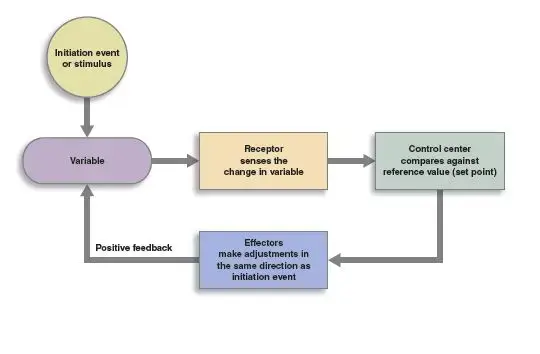
Steps of positive feedback mechanism
The positive feedback mechanism operates as a regulatory system, amplifying deviations from a set point or equilibrium. This mechanism, while less common than its negative counterpart, plays a crucial role in specific biological processes requiring rapid and intensified responses. The steps or processes involved in a positive feedback mechanism can be delineated as follows:
- Stimulation: The inception of the positive feedback loop is marked by an initiating stimulus. In biological contexts, this often manifests as hormones secreted by various organs in response to a particular event or change. This stimulus serves as the catalyst, setting the feedback loop into motion.
- Reception: Following the initial stimulation, the system’s receptors detect the change. These receptors, predominantly nerve cells, are responsible for capturing the stimulus and transmitting the associated signals to a control center. In humans, the brain typically functions as this control center, processing and interpreting the incoming signals.
- Processing: Once the control center, such as the brain, receives the signals from the receptors, it undertakes the task of information analysis. The control center evaluates the incoming data against a predefined set point or range. If the received stimulus deviates significantly from this set point, the control center prepares to generate an appropriate output.
- Amplification of Stimuli: The final step in the positive feedback loop involves the transmission of directives from the control center to the target site or effector. This transmission, often facilitated by neural pathways, instructs the effector to respond to the initial stimulus. However, in the context of a positive feedback mechanism, this response serves to further amplify or enhance the initial deviation. The system continues to intensify the stimulus until a certain endpoint is reached or an external factor intervenes to halt the process.
In essence, the positive feedback mechanism operates as a self-reinforcing loop, where each cycle intensifies the deviation from the norm. While this can lead to rapid and pronounced changes, it is essential for processes that require swift and decisive actions.
Positive feedback mechanism examples
Positive feedback mechanisms are regulatory systems that amplify or enhance deviations from a set point or equilibrium. These mechanisms are crucial in specific biological processes that necessitate rapid and pronounced responses. Here are some illustrative examples of positive feedback mechanisms:
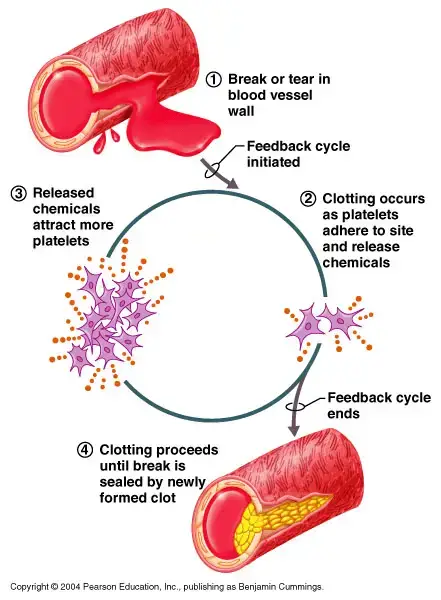
- Blood Clotting: When an injury results in bleeding, the body’s immediate response is to initiate the clotting process to prevent excessive blood loss. The injured blood vessel releases substances that activate clotting. Platelets adhere to the injury site and release chemicals that attract more platelets. This accumulation and chemical release amplify the clotting process, a classic example of a positive feedback loop, until a clot forms sufficiently to stop the bleeding.
- Childbirth: Childbirth in humans is regulated by a positive feedback mechanism. The process begins when the baby exerts pressure against the cervix. This pressure is sensed and transmitted as nerve impulses to the brain, prompting the release of the hormone oxytocin. Oxytocin induces uterine contractions, pushing the baby further against the cervix and intensifying the stimulus. This cycle continues, with increasing oxytocin levels and stronger contractions, until the baby is delivered.
- Menstrual Cycle: At the onset of the menstrual cycle, the ovaries release the hormone estrogen. This release acts as a stimulus for the brain, leading the hypothalamus to release gonadotrophin-releasing hormone and the pituitary gland to release luteinizing hormone. These hormones, in turn, stimulate the ovaries to produce more estrogen. This cycle repeats, amplifying the hormonal response until follicle-stimulating hormone is released, culminating in ovulation and the commencement of the menstrual cycle.
- Fruit Ripening: A fascinating phenomenon in nature is the synchronized ripening of fruits on a tree. The initial ripening fruit releases ethylene gas, which acts as a stimulus for neighboring fruits to ripen. As these fruits ripen, they too release ethylene, perpetuating the ripening process in a wave-like manner across the tree. This positive feedback loop is harnessed commercially, with fruits being exposed to ethylene gas to expedite ripening.
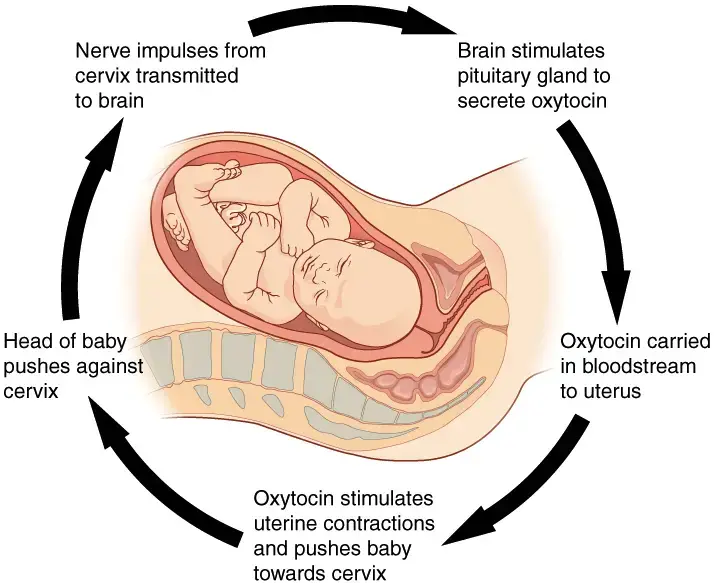
In summary, positive feedback mechanisms play pivotal roles in various biological processes, ensuring swift and decisive actions in response to specific stimuli. These mechanisms, while amplifying deviations, are crucial for processes that require rapid and intensified responses.
2. Negative feedback mechanism
- A negative feedback mechanism is a regulatory system integral to maintaining stability and equilibrium within biological and other systems. Contrary to positive feedback mechanisms that amplify deviations, negative feedback mechanisms counteract and mitigate changes, ensuring that a system remains close to a desired set point or equilibrium.
- At its core, a negative feedback mechanism operates by detecting deviations in output. Once a deviation is identified, the mechanism initiates corrective actions that produce changes in the opposite direction of the initial deviation. This counteractive response ensures that the system returns to its desired state or homeostasis.
- For instance, when a system’s output exceeds its desired set point, the negative feedback mechanism reduces the output. Conversely, if the output falls below the desired set point, the mechanism increases the output. This self-regulating nature of negative feedback mechanisms ensures that systems remain stable and resist abrupt or drastic changes.
- The control unit plays a pivotal role in the functioning of the negative feedback mechanism. It continuously monitors and analyzes the system’s current state, comparing it to the desired set point. If discrepancies arise, the control unit orchestrates the necessary corrective actions to bring the system back to equilibrium.
- In comparison to positive feedback mechanisms, which are designed to amplify deviations and are less common, negative feedback mechanisms are ubiquitous. Their prevalence can be attributed to their inherent ability to stabilize systems, making them indispensable in maintaining homeostasis in various biological processes.
- In summary, negative feedback mechanisms are foundational to the stability and equilibrium of systems. By counteracting deviations and driving systems towards homeostasis, they ensure consistent and optimal functioning.
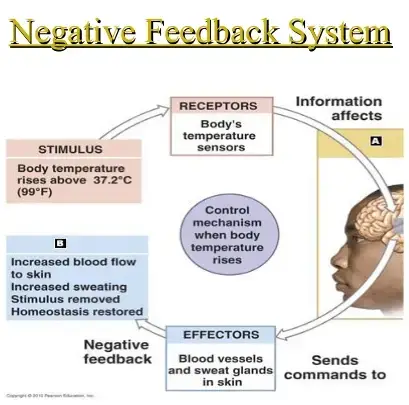
Steps in a negative feedback mechanism
A negative feedback mechanism is a fundamental regulatory process that ensures stability and homeostasis within systems. This mechanism operates by counteracting deviations from a set point, ensuring that systems remain within desired parameters. The steps involved in a negative feedback mechanism are as follows:
- Stimulation: The initiation of a negative feedback mechanism begins with the detection of deviations in physiological parameters from their established norms. These deviations can arise due to various internal or external factors and can occur in either direction—increasing or decreasing from the set point.
- Reception: Once a deviation is detected, it is relayed to the control unit through specialized receptors distributed throughout the system. These receptors, which can be nerves, thermoreceptors, or other sensory cells, are adept at sensing changes and transmitting this information to the central control unit, typically the brain.
- Processing: The control unit, upon receiving the information about the deviation, processes it to determine the magnitude and direction of the change. Based on this analysis, the control unit decides whether to activate or inhibit the feedback loop. It formulates a response strategy to address the detected deviation, ensuring that the system returns to its desired state.
- Counteraction: In the final step, the control unit dispatches corrective signals aimed at neutralizing the effects of the initial deviation. These signals are directed towards specific effectors or organs that can bring about the necessary changes to restore equilibrium. Depending on the nature of the deviation, these corrective actions can involve increasing or decreasing certain physiological activities, releasing specific hormones, or adjusting metabolic rates.
In essence, a negative feedback mechanism operates as a self-regulating system, continuously monitoring and adjusting to maintain stability and homeostasis. By promptly detecting and counteracting deviations, it ensures that systems function optimally and remain within their desired parameters.
Examples of negative feedback
Negative feedback mechanisms are pivotal in maintaining homeostasis within biological systems. These mechanisms detect deviations from a set point and initiate responses to counteract and restore the system to its desired state. Here are some illustrative examples of negative feedback in action:
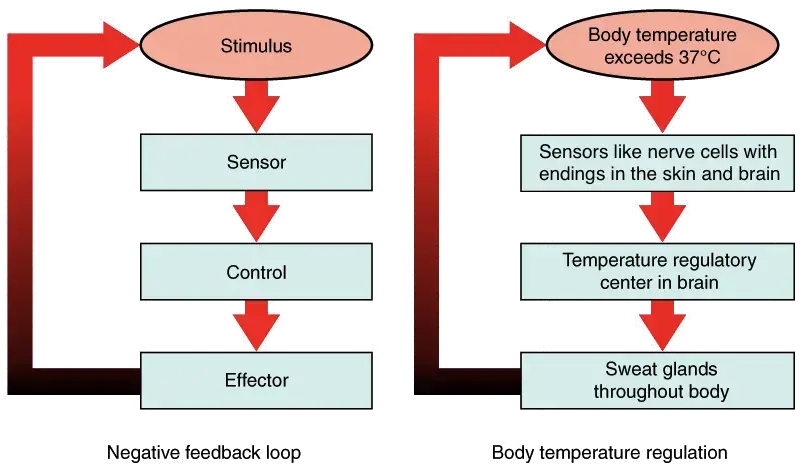
- Thermoregulation: The human body employs a sophisticated negative feedback system to regulate its internal temperature, ensuring it remains close to an average of 37°C (98.6°F). When the body’s internal temperature rises above this set point, thermoreceptors in the skin and brain detect this change. In response, the hypothalamus, a region in the brain, triggers mechanisms like vasodilation (widening of blood vessels) and sweating to dissipate excess heat. Conversely, if the body’s temperature drops below the set point, the hypothalamus activates mechanisms like vasoconstriction (narrowing of blood vessels) and shivering to generate and conserve heat. These actions ensure that the body’s temperature remains stable and within a narrow range, despite external environmental fluctuations.
- Glycemic Control: The regulation of blood glucose levels is another quintessential example of a negative feedback mechanism. When blood glucose levels rise post-meal, the pancreas secretes insulin, a hormone that facilitates the uptake of glucose by cells, particularly muscle and liver cells. This uptake reduces the glucose concentration in the bloodstream. On the other hand, when blood glucose levels drop, perhaps due to fasting or strenuous activity, the pancreas releases glucagon. This hormone stimulates the liver to convert stored glycogen into glucose, which is then released into the bloodstream. Through these opposing actions of insulin and glucagon, the body ensures that blood glucose levels remain within a tight range, providing a steady energy supply to cells.
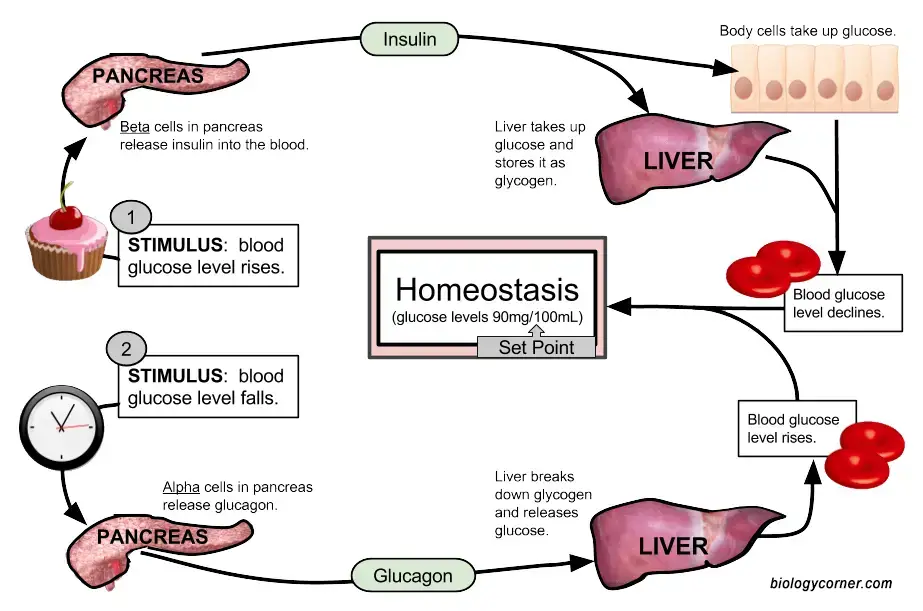
These examples underscore the importance of negative feedback mechanisms in preserving the stability and functionality of biological systems. By continuously monitoring and adjusting, these mechanisms ensure that physiological parameters remain within optimal ranges, safeguarding the overall health and well-being of the organism.
Differences Between Positive vs. Negative Feedback Mechanism
Distinguishing between positive and negative feedback mechanisms is crucial for understanding how biological systems maintain equilibrium and respond to external stimuli. These mechanisms, while both integral to homeostasis, operate in fundamentally different ways. Here’s a comprehensive comparison between the two:
Positive Feedback Mechanism vs. Negative Feedback Mechanism:
- Result:
- Positive Feedback Mechanism: Leads to an amplification or enhancement of the initial change or deviation.
- Negative Feedback Mechanism: Counteracts the initial change, working to restore the system to its set point or equilibrium.
- Occurrence:
- Positive Feedback Mechanism: Less commonly observed in biological systems.
- Negative Feedback Mechanism: More prevalent, as it’s essential for maintaining homeostasis in various physiological processes.
- Effects on Stimulus:
- Positive Feedback Mechanism: Reinforces or intensifies the stimulus, leading to a further deviation from the set point.
- Negative Feedback Mechanism: Opposes or diminishes the stimulus, aiming to bring the system back to its desired state or set point.
- Stability:
- Positive Feedback Mechanism: Generally less stable, as it can lead to extreme changes unless externally regulated or until a specific endpoint is reached.
- Negative Feedback Mechanism: Promotes stability by constantly adjusting and maintaining parameters within a narrow range.
- Practical Examples:
- Positive Feedback Mechanism: Processes like blood clotting, fruit ripening, childbirth in mammals, and certain phases of the menstrual cycle.
- Negative Feedback Mechanism: Examples include the regulation of body temperature and the control of blood glucose levels.
In essence, while positive feedback mechanisms amplify changes and can drive processes to completion, negative feedback mechanisms are the body’s primary tool for maintaining stability and homeostasis. Both types of feedback play vital roles in ensuring the proper functioning and adaptability of biological systems.
Importance of Feedback mechanism
Feedback mechanisms are fundamental to the stability and functionality of biological, ecological, and even technological systems. Their importance can be understood through the following points:
- Maintenance of Homeostasis: Feedback mechanisms, especially negative feedback loops, are essential for maintaining homeostasis in organisms. Homeostasis ensures that internal conditions remain stable and relatively constant, allowing organisms to function optimally despite external changes.
- Adaptation to Changes: Feedback mechanisms allow systems to adapt to changes in the environment or internal conditions. This adaptability is crucial for the survival of organisms in varying environmental conditions.
- Efficiency: Positive feedback mechanisms can amplify specific processes, making them more efficient. For instance, the clotting of blood is expedited through a positive feedback loop, ensuring rapid wound healing.
- Regulation of Growth and Development: Feedback mechanisms regulate growth and developmental processes in organisms, ensuring that they occur at the right time and in the right sequence.
- Protection: Feedback mechanisms can protect organisms from harm. For instance, when body temperature rises, sweating (a negative feedback mechanism) helps cool the body down, preventing overheating.
- Dynamic Equilibrium in Ecosystems: In ecological systems, feedback mechanisms help maintain a dynamic equilibrium. For example, predator-prey relationships are governed by feedback loops that ensure neither population grows too large or too small.
- Technological Applications: Feedback mechanisms are not limited to biological systems. They are widely used in technology, especially in control systems, to ensure devices operate within desired parameters. For instance, thermostats use feedback mechanisms to maintain room temperature.
- Learning and Decision Making: Feedback is crucial in learning processes and decision-making, both for humans and artificial intelligence systems. Receiving feedback helps in refining strategies, improving performance, and achieving desired outcomes.
- Stabilization of Economic Systems: In economics, feedback mechanisms help stabilize markets. For example, when demand for a product increases, prices may rise, leading to increased production, which eventually brings prices back down.
- Enhancement of Processes: In certain situations, it’s beneficial for a process to be amplified or accelerated. Positive feedback mechanisms can enhance such processes until a specific endpoint or goal is achieved.
In summary, feedback mechanisms are integral to the functioning and stability of various systems, from cellular processes in our bodies to global ecological cycles. They ensure that systems can adapt, respond, and evolve in the face of changing conditions.
Quiz Practice
Which of the following best describes a feedback mechanism?
a) A process that amplifies system changes
b) A process that only reduces system changes
c) A system’s response to a change to return to a set point
d) A system’s response to permanently change its set point
Which feedback mechanism tends to stabilize a system?
a) Positive feedback
b) Negative feedback
c) Neutral feedback
d) None of the above
Which of the following is an example of a positive feedback mechanism?
a) Body temperature regulation
b) Blood clotting
c) Blood glucose level regulation
d) Breathing rate adjustment
What is the primary purpose of negative feedback mechanisms in the human body?
a) To amplify deviations
b) To maintain homeostasis
c) To accelerate processes
d) To disrupt stability
In which feedback mechanism does the response enhance the original stimulus?
a) Negative feedback
b) Neutral feedback
c) Positive feedback
d) None of the above
Which component of a feedback mechanism detects changes in the environment?
a) Effector
b) Control center
c) Receptor
d) Stimulus
In the regulation of blood glucose levels, which hormone lowers blood sugar when it’s too high?
a) Glucagon
b) Insulin
c) Adrenaline
d) Cortisol
Which of the following processes is regulated by a positive feedback mechanism?
a) Blood pressure regulation
b) Childbirth
c) Heart rate regulation
d) Respiratory rate
What happens in a negative feedback mechanism when the set point is achieved?
a) The response is amplified
b) The response is reduced or stopped
c) The set point changes
d) The stimulus is enhanced
In which feedback mechanism can the response often lead to an extreme or uncontrolled situation?
a) Neutral feedback
b) Negative feedback
c) Positive feedback
d) All of the above
FAQ
What is a feedback mechanism?
A feedback mechanism is a process in which a system responds to a change by either returning to its original state or by amplifying the change.
How do feedback mechanisms maintain homeostasis?
Feedback mechanisms help maintain homeostasis by detecting deviations from a set point and triggering responses to bring the system back to that set point.
What is the difference between positive and negative feedback mechanisms?
Positive feedback amplifies changes, often leading to an extreme or uncontrolled situation, while negative feedback opposes changes, bringing the system back to its set point.
Are positive feedback mechanisms harmful?
Not necessarily. While positive feedback can lead to extreme situations, it is essential in certain processes like childbirth and blood clotting.
Why is negative feedback more common in biological systems?
Negative feedback mechanisms are more common because they help maintain stability and homeostasis, which are vital for the survival of organisms.
Can one system have both positive and negative feedback mechanisms?
Yes, many systems, especially in biology, can have both types of feedback mechanisms operating under different conditions.
What role do receptors play in feedback mechanisms?
Receptors detect changes in the environment or within the system and send this information to the control center to initiate a response.
How does the body regulate temperature using feedback mechanisms?
When the body’s temperature deviates from the set point, receptors detect this change and send signals to the brain, which then triggers responses like sweating (to cool down) or shivering (to warm up) to return to the set point.
Are feedback mechanisms only found in biological systems?
No, feedback mechanisms are also found in non-biological systems, such as in engineering, electronics, and economics.
Why is understanding feedback mechanisms important in medicine?
Understanding feedback mechanisms is crucial in medicine to diagnose diseases, understand body responses to treatments, and develop therapeutic interventions that can modify or harness these feedback loops for better health outcomes.
References
- Biga, L., Dawson, S., Harwell, A., Hopkins, R., Kaufmann, J., LeMaster, M., Matern, P., Graham, K., Quick, D., & Runyeon, J. (2021). Anatomy and Physiology. Link
- Lumen Learning. (2019). Homeostasis from Boundless Anatomy and Physiology. Link
- Kahn Academy. (2019). Homeostasis. In Human Body Systems. Link
- Torday, J. S. (2021). Homeostasis as the Mechanism of Evolution. Biology, 4(3), 573-90. DOI: 10.3390/biology4030573
- Wakim, S., & Grewal, M. (2021). Homeostasis and Feedback. Link
- Text Highlighting: Select any text in the post content to highlight it
- Text Annotation: Select text and add comments with annotations
- Comment Management: Edit or delete your own comments
- Highlight Management: Remove your own highlights
How to use: Simply select any text in the post content above, and you'll see annotation options. Login here or create an account to get started.